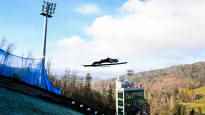The sight certainly didn’t disappoint those dedicated to ski jumping.
When the women and men opened the World Cup season on November 5 in Poland, the downhill slope of Wisla suurmäki glowed green in the glow of the evening lights.
The Hill Jumping World Cup was jumped in rain for the first time on plastic instead of snow, in other words on a summer platform.
The rain was not a problem for the organizers, but the temperature of almost 10 degrees was. Only the speed hill met the hallmarks of the World Cup, thanks to the ice track familiar from the winter season.
Snowing the hill was out of the question in mild and rainy conditions. If this had been attempted, it would have cost the organizers tens of thousands of euros.
Hill jumping is a snow sport, and creating a white hill usually does not cause problems during the winter – whether it is natural snow or artificial snow.
However, the situation may be different in the beginning and end of winter.
The blocking back found himself in a difficult situation
The Salpausselkä World Cup competitions in Lahti have mainly been held on the weekend after the prize competitions, at the turn of February and March.
This season, the World Cup medals will be fought in Planica, Slovenia. The competition ends on March 5.
The Executive Director of the Ski Association Ismo Hämäläinen according to Lahti wanted the World Cup to organize the 10th–12th March, but the wishes of the Norwegian skiing decision-makers took precedence over the Finns.
First, the officials of biathlon, which enjoys the highest TV visibility in skiing, announced that their World Cup will culminate at Oslo’s Holmenkollen on the 16th-19th. March.
This forced the Nordic skiing events for Kollen at the time Lahti wanted, because there is no time to compete in the nine-day ski jumping RAW air tour in Norway at the end of March.
Since the most cost-effective way for the Finnish Ski Federation to organize World Cup competitions is to have ski jumping on the same weekend as cross-country and combined, the Finns were left with 24-26 after the Norwegians’ division. March.
– That’s when the superpower politics of skiing became visible. It was a chain reaction. Both functionally and financially, we had to take the competition to that point. We had no choice, Hämäläinen says.
Is the thermal spring coming?
When examining the weather maps from the early years of recent years, the last weekend of March can cause challenges for Salpausselkä race organizers.
The term thermal spring describes the time when the daily average temperature rises more permanently above zero degrees. According to the Finnish Meteorological Institute, thermal spring began in Lahti this year on April 12 and last year on March 23.
If we moved at the same times next March, there would be no problems, but there are other examples. In 2020, the temperature rose permanently above zero degrees as early as February 9. In the years 2015–2019, the thermal spring has started between February 19 and March 25.
Hämäläinen admits that starting the World Cup season with plastic made him think about whether it’s worth sticking to his snow status if the weather conditions don’t support it.
Hämäläinen still states that jumping on plastic is not in the plans for Salpausselkä’s 100th anniversary competitions.
– I could see that jumping on the snow would be nurturing honorable traditions.
– The risk analysis is done at the stage when we are a little closer. Both of these models must of course be taken into account, says Hämäläinen.
The competition manager of the Salpausselkä Games, a former top jumper Tami Kiurun according to the organizers, jumping on plastic has not occurred to them.
– We are preparing during the winter to be able to make snow in such a way that you can jump on the snow.
Hoping for a return to the old days
The final decision on snowmaking is made by the city of Lahti, which owns the performance venues and is responsible for their maintenance.
Let’s jump to the World Cup in Lahti on any platform, Hämäläinen hopes that it will be an exceptional year.
– The skiing association’s big goal is that the Salpausselkä competitions would be organized a week after the prestigious competitions in the future.
– Our hope is that FIS’s calendar solutions allow for more long-term decisions. Locking the World Cup calendar a few months before the start of the season is not a sustainable solution, says Hämäläinen.
